The revision 3.1B board with some minor changes. As an alternative, its now possible to solder some cheap SMD switches instead of useing the expensive Marquard keys. However, the look and feel isn’t the same. There is also a new jumper switch to select between the upper and lower part of the system ROM. So you can hold two different systems and change it on the fly. Also the new Junior Computer ][ logo is printed on the PCB.
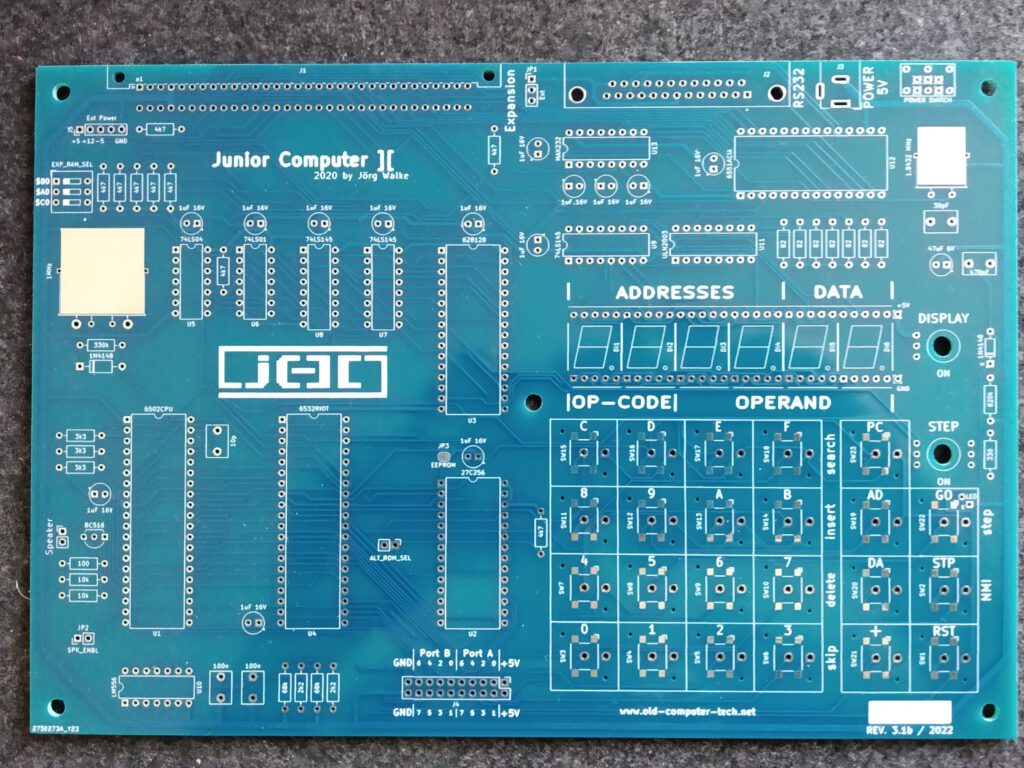
The first assembled IO/Language Card with I2C Bus, Real Time Clock, user VIA ports, SPI interfaced SD-Card reader, SN76489 Sound Chip with audio amplifier, Datasette connector, parallel printer port, ASCII keyboard connector, and ROM for EhBasic or other programming languages.
Heavy programming sessions are coming up to bring it all alive…
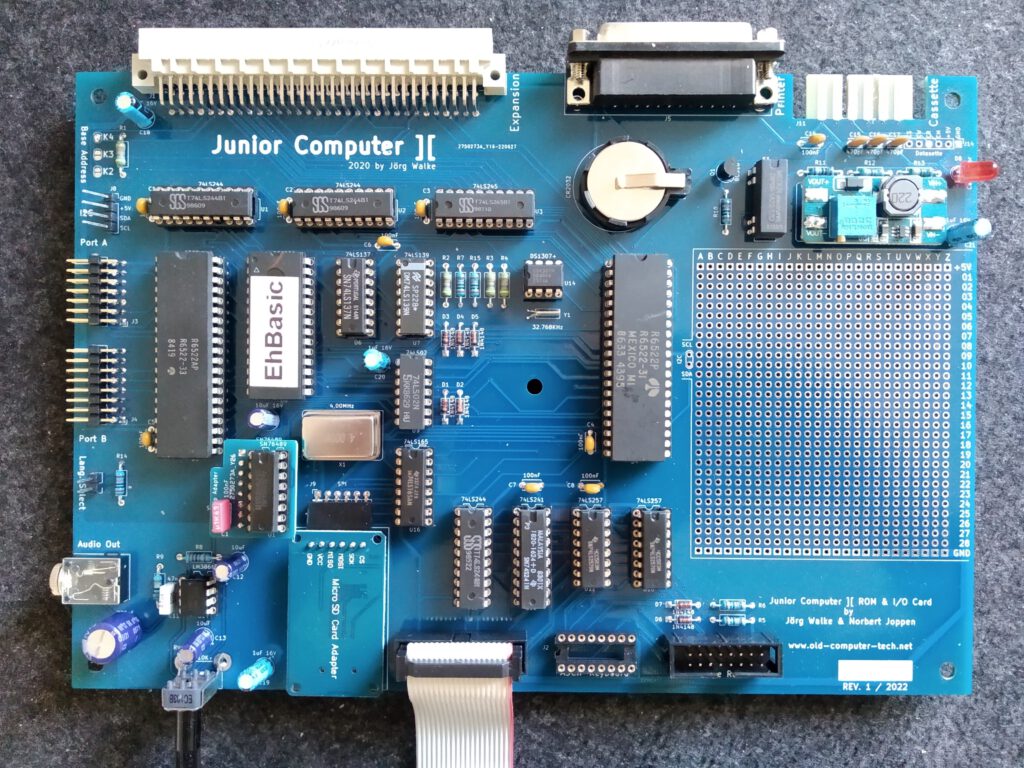
Because of a misunderstood datasheet for the Sound Chip, a little adapter PCB was necessary and on the bottom side of the PCB some extra diodes and resistors needed to be soldered. The marker notch of the Datasette connector was on the wrong position, so I used a saw to place it on the correct possition. The old notch is filled up with epoxy resin. Of course, the new circuit board no longer has these issues.
IO/Language Card stacked over the Junior Computer ][
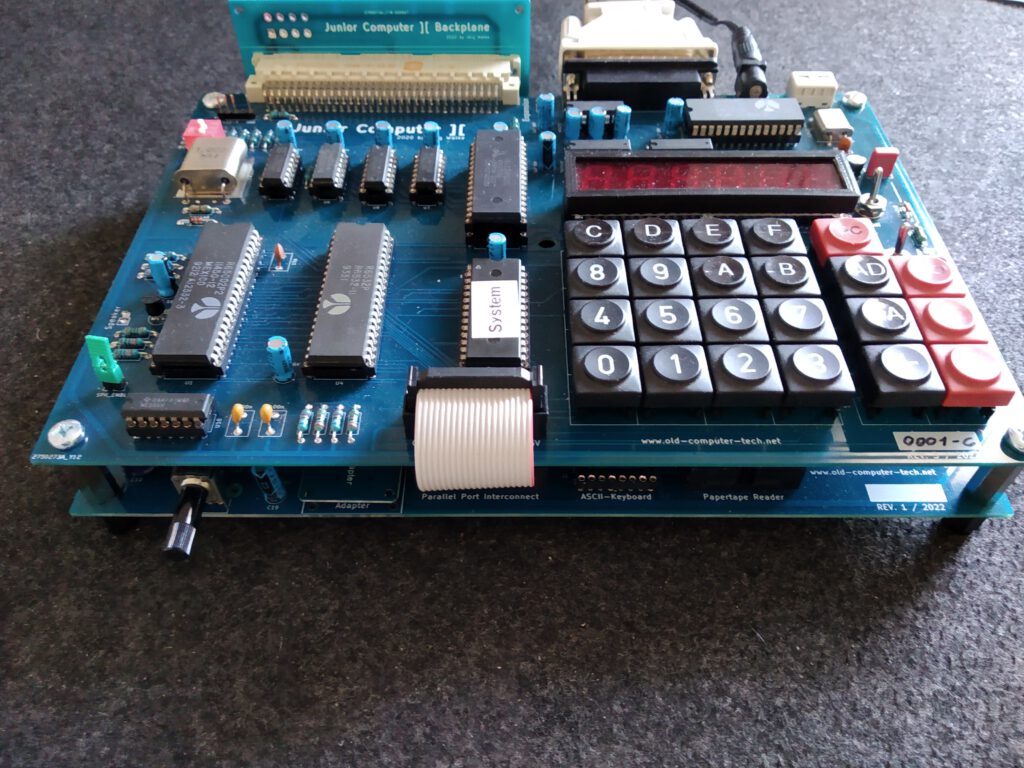
The new revision 3 boards has arrived
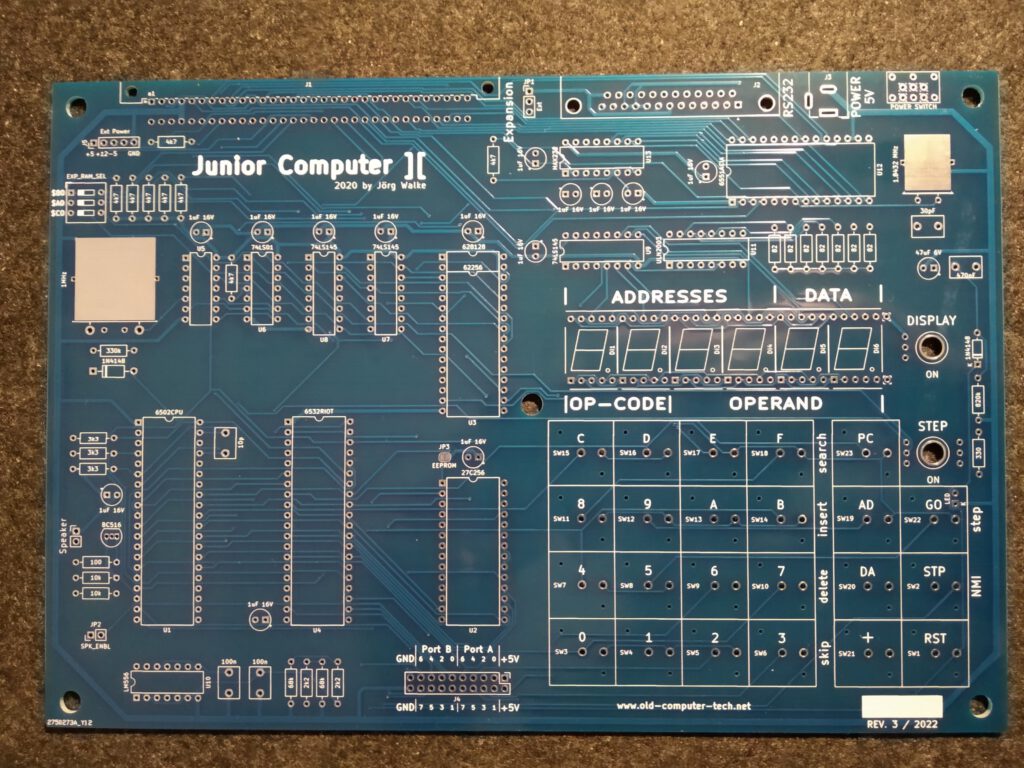
…all components assembled and soldered
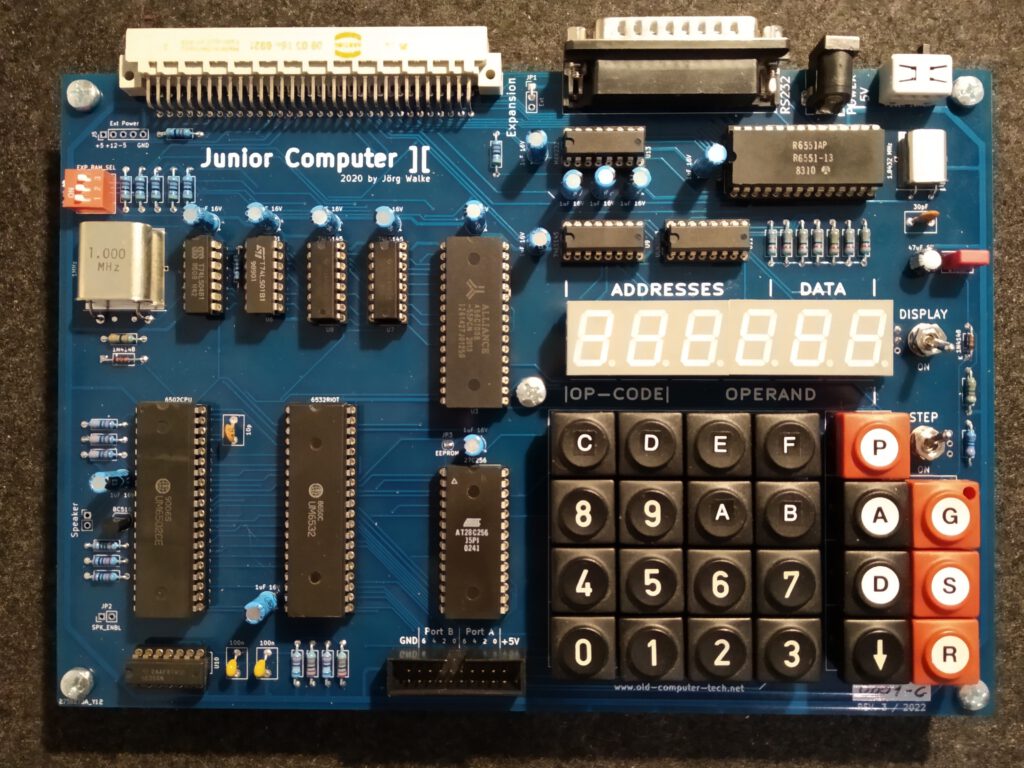
…and it works fine!
Its new features are: Up to 128KB RAM chips installable. 3 DIP switches to configure three additional 8KB RAM banks. Maximum of 51712 Bytes usable with 64KB RAM chip. Auto reset at power on. A power switch (oh yeah). Usable Memory for string buffers in the address area of the ACIA.

Hi Joerg.
My name is Torbjorn, Swedish background but since 1981 living in Sydney Australia.
Thank you so much for making this updated Junior ][ available to everyone. Fantastic job you have done updating the the original machine, I especially like the serial port.
I do have the original Elektor one and I also built the new one by Bram. This was my first computer and I had some good memories playing with this machine whilst studying. I am just about to place my order with JLCPCB, is there anything I should be aware of with this 3b version. It will take some time to get some of the parts from Mouser, mainly the switches and key caps. I am happy to wait some months if you are close with the IO board you mentioned, if not then all good I will order now.
Thanks again
Torbjorn
Hi Torbjorn, sorry for my late response. I was so busy building the JC 2 IO/Language Card (and other things), that I didn’t realized, that you have written this post.
I hope you finished building your Rev. 3B board and made it alive. It’s a pleasure to see so many Junior Computer fans that find my little extended version useful. The Rev. 3B boards have no known issues, nevertheless there is a new 3.1B PCB out now. On this board you can place some cheap SMD keys as an alternative to the expensive Marquard switches. There is also a new jumper to switch between the upper and lower half of a 32KB ROM. So it is possible to have two different ROM Versions (maybe your own) available.
The IO/Language Card is now ready and running. But there is much to do bringing it fully alive. For now the Real Time Clock is working, as is the I2C interface. I’m working on the documentation to make it available for download.
I will make some posts about the IO/Language card maybe in the next two weeks.
Greetings
Jörg
Hi Joerg,
All good ordered the PCBs and assembled one. Board worked with no issues, only problem was that my first 6502 was a dud and I also used Arduino female connectors initially for the 7 segment LCDs and they gave me some contact issues. The key switches are great but I am still waiting for the supply of blank keycaps. I swapped out the ram memory for a Dallas DS1245Y non-volatile memory. My only comment is that the
1 meg Hz Crystals a quite expensive but only one is required so not a problem. You are doing a great job and I am looking forward to your IO board.
Thanks again,
Torbjorn
Hi Torbjorn,
nice to hear, that your Junior ][ is working. It’s an honor to see that he made it’s way to Down Under.
It’s a great idea to use the DS1245Y. I will include this type of memory in the parts list, if this is OK for you.
Yes the old HC33 type 1MHz Crystal is quite expensive. That’s the reason why I also placed solder pads for a small HC43/U Crystal. However, the big ones just look so much better.
If you want to make your own key labels, you can use a Brother label printer that is able to print white on black for black key caps or black on transparent for yellow or red caps or so. Then use a 10mm leather punch to cut them out. That worked absolute fine for me.
The first IO/Language Cards are now running and the printer, the I2C interface and the RTC are working fine. For the other components I still have to write the code, which will took some time.
Thank you for your support,
Jörg
Hi Torbjorn,
I just looked up the data sheet of the DS1245Y and find that it do not have the second chip select line at pin 30. For the AS6C1008 SRAMs this line was absolutly nessesary to make the Junior ][ work fine, because I used this CS line to synchronize the memory with the PHI2 clock. If you run into trouble calling sub routines, then this is the issue.
Jörg
Hi Joerg,
Greetings from Down Under.
Yes I use brother label printer as well. Thanks for you warning about CS and synchronize with PH12. So far I have not seen a problem but I will be on the lookout. I am not a programmer so anything I do will be very basic.
Connected up the serial port for the first time yesterday. I am getting garbage on Tera Term. I don’t trust the 6551 I have and even the Max232 may not be ok, so I used the TTL levels with USB converter but so far no go, tried all different baud rates. Many of the parts I have are supplied from different seller on AliExpress so can’t always be sure about what works. It may take some time but I will get it sorted.
Cheers,
Torbjorn
Hi Torbjorn,
greetings back from Germany.
The problem with the weird TeraTerm output definitively look for me like a RAM issue. Because the CPU is calling some subroutines and the RAM is not synchronized with PHI2, it writes garbage for the return address on the stack and the routine returns to somewhere. That is so, because of some timing problems with newer 65(C)02 CPUs and also maybe because the RAM chips. The old 1MHz NMOS 6502 was more tolerant on write cycles than the newer (faster) ones.
Please try a normal 64KB (W24512A) or 128KB (626128) RAM chip as supposed in the assembly instructions. If you use other SRAMS be sure that pin 30 is a CS2 (non inverting) input. I think that should vanish your problem.
Jörg
Hi Jorge,
My 6502 is the NMOS version that runs a bit warm. I did already try my ram HM628128, with a non inverting CS pin 30. Unfortunately this made no difference.
I still suspecting the UM6551 setup, my crystal inputs as very low at around 1 volt and the cap is correct 30p. I took the cap out for testing purpose but levels did not change. I could not find any specs on the min levels for the Xtal input. I ordered a couple R6551 and I will keep you posted on my progress. I hope this has not been much distraction, I would hate taking any time away from your project.
Cheers,
Torbjorn
Hi Torbjorn,
the voltage level of the crystal seems to be OK. It should be around 1 and 1.5V . I also suspect the 6551 ACIA if the RAM is properly working. Keep me updated if you make progress. And don’t worry. Distraction is fine for me 🙂
Jörg
Hi Jorge,
Up and working with serial interface and all keycaps now.
After replacing 6551 and the MAX232 and still no joy. I changed my USB converter and the cabling. The problem was the 1.5m cable using TTL I/F.
I did not expect the cabling to be the problem since the garbage on TeraTerm was consistent characters. I will now try the DS1245 and let you know if it is stable.
Looking forward to your I/F card, I can see that it is not possible to download yet.
Again I very much appreciate the work you are doing.
Cheers,
Torbjorn
Hi Torbjorn,
this are good news. I’m really glad to hear about your success and I hope you have fun with the Junior ][ so far.
The interface card is already working very well and I’m making progress programming all the individual parts. The I2C Bus, Printer port, the Clock and the Sound Chip are working fine. For now I’m working on the Datasette support, were I just finished the code for writing to, and reading from the tape. But there are much other things to do. I also patched EhBasic to run on the Junior but with very little Hardware support so far.
The Gerbers for the IO Board and all other files are ready to download. But the circuit that is switching the the motor of the Datasette needs a little patch. So its better to wait with the download until I managed to include the fix on the PCB.
Let me know if the DS1245 is working. But I suppose it will not.
Greetings
Jörg
Hi Jörg,
Great to hear about your progress.
Yes I do enjoy your creation and I will try to be patient as I am waiting for the I/O board.
So far the DS1245 appears to work, I only do small programs but I get no lock-ups or scrambled memory and after power off all content is working weeks later.
Cheers,
Torbjorn
Hi Jörg,
I am going to build your Junior Computer ][.
Already orderd all parts and the PCB is on its way.
Instead of using a 1Mhz crystal, does it also work with a 2Mhz crystal?
Hi Ronald,
sorry for my late response. Nice that you want to build the Junior 2. I hope you will enjoy it.
The JC2 on it self should working fine with 2MHz. I didn’t do any test with expansion cards, such as the IO board, so far. But changing the crystal back to 1MHz is no deal.
Ha Jorg,
As we speak, I am building the JC2 together with a friend.
We run into a problem.
After building and burning firmware v1.02, we do not get any reaction of the board.
We do not have build the IO card, so does firmware 1.02 also work without the IO card?
We have checkt all components and set all jumpers rigt.
Do you have a clue?
Thanks
Regards,
Ronald